ROBERTS RULES OF ORDER
THE COMPLETE AND OFFICIAL
1893 STANDARD GUIDE
TO PARLIAMENTARY PROCEDURE
NOW, FULLY ILLUSTRATED WITH
RULES-IN-ACTION
PTA meetings, church groups, womens groups, chambers of commerce, governing bodies, civic groups, political groups, schools, colleges, and organizations of every type for nearly one hundred years have used Roberts Rules of Order to conduct business fairly at formal meetings.
Now, Roberts has a whole new look. The revealing illustrations in this new edition make the details of the rules and conduct-of-business crystal clear, easier to use, and more valuable to a wider range of groups and organizations.
This edition contains the complete text
of the original hardcover edition.
NOT ONE WORD HAS BEEN OMITTED.
ROBERTS RULES OF ORDER
A Bantam Book/published by arrangement with
Poor House Press
PUBLISHING HISTORY
Poor House Press edition published 1982
Certain liberties in layout and arrangement of text have
been made in the original work which was first published in 1876
by General H.M. Robert.
Bantam edition/November 1986
All rights reserved.
Copyright 1982 by Poor House Press.
Artwork and illustrations copyright by Will Eisner and are
property of the artist.
No part of this book may be reproduced or transmitted
in any form or by any means, electronic or mechanical,
including photocopying, recording, or by any information
storage and retrieval system, without permission in writing
from the publisher.
For information address: Poor House Press,
8333 West McNab Road, Suite 114, Tamarac, Florida 33321.
eISBN: 978-0-307-78995-2
Bantam Books are published by Bantam Books, a division of Random House, Inc. Its trademark, consisting of the words Bantam Books and the portrayal of a rooster, is Registered in U.S. Patent and Trademark Office and in other countries. Marca Registrada. Random House, Inc., New York, New York.
v3.1
TABLE OF CONTENTS
PART I.
RULES OF ORDER.
PART II
ORGANIZATION AND CONDUCT OF BUSINESS.
PART III.
MISCELLANEOUS.
TABLE OF RULES RELATING TO MOTIONS
The following Table furnishes, (1) an index to the rules relating to motions; (2) lists of the motions belonging to each of the seven classes indicated by the headings to the columns (by noticing the black squares in each column); and (3) lists of the motions to which these headings in part apply, the extent to which they apply being shown in notes referred to by figures in the columns. After the Table, . For further information in regard to motions examine the Index under the title Motions.
(Numbers that may appear in columns of the chart refer to these notes.)
QUICK REFERENCE CHART
FOR USE AT MEETINGS
 Black square shows which rule applies
Black square shows which rule applies
 Number refers to Notes
Number refers to Notes
NOTES
 Every motion in this column has the effect of suspending some rule or established right of deliberative assemblies (see note to ), and therefore requires a two-thirds vote, unless a special rule to the contrary is adopted.
Every motion in this column has the effect of suspending some rule or established right of deliberative assemblies (see note to ), and therefore requires a two-thirds vote, unless a special rule to the contrary is adopted.
 Undebatable if made when another question is before the assembly.
Undebatable if made when another question is before the assembly.
 An Amendment may be either (1) by adding or (2) by striking out words or paragraphs; or (3) by striking out certain words and inserting others, or (4) by substituting a different motion on the same subject; or (5) by dividing the question into two or more questions as specified by the mover, so as to get a separate vote on any particular point or points.
An Amendment may be either (1) by adding or (2) by striking out words or paragraphs; or (3) by striking out certain words and inserting others, or (4) by substituting a different motion on the same subject; or (5) by dividing the question into two or more questions as specified by the mover, so as to get a separate vote on any particular point or points.
 An Appeal is undebatable only when relating to indecorum, or to transgressions of the rules of speaking, or to the priority of business, or when made while the Previous Question is pending. When debatable, only one speech from each member is permitted. On a tie vote the decision of the Chair is sustained.
An Appeal is undebatable only when relating to indecorum, or to transgressions of the rules of speaking, or to the priority of business, or when made while the Previous Question is pending. When debatable, only one speech from each member is permitted. On a tie vote the decision of the Chair is sustained.
 An affirmative vote on this motion cannot be reconsidered.
An affirmative vote on this motion cannot be reconsidered.
 The objection can only be made when the question is first introduced, before debate.
The objection can only be made when the question is first introduced, before debate.
 Allows of but limited debate upon the propriety of the postponement.
Allows of but limited debate upon the propriety of the postponement.
 The Previous Question, if adopted, cuts off debate and brings the assembly to a vote on the pending question only, except where the pending motion is an amendment or a motion to commit, when it also applies to the question to be amended or committed.
The Previous Question, if adopted, cuts off debate and brings the assembly to a vote on the pending question only, except where the pending motion is an amendment or a motion to commit, when it also applies to the question to be amended or committed.
 Can be moved and entered on the record when another has the floor, but cannot interrupt business then before the assembly; must be made on the day, or the day after, the original vote was taken, and by one who voted with the prevailing side.
Can be moved and entered on the record when another has the floor, but cannot interrupt business then before the assembly; must be made on the day, or the day after, the original vote was taken, and by one who voted with the prevailing side.
RULES OF MOTIONS
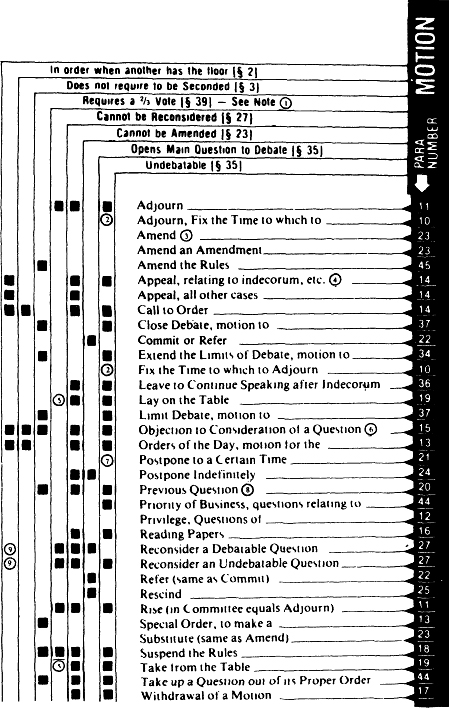
Duplicate of this chart appears on inside back cover for use as quick reference during meetings.
ADDITIONAL RULES TO ACCOMPANY TABLE
Order of Precedence of Motions.
The ordinary motions rank as follows, and any of them (except to amend) can be made while one of a lower order is pending, but none can supersede one of a higher order; the Previous Question requires a two-thirds vote, the others only a majority:
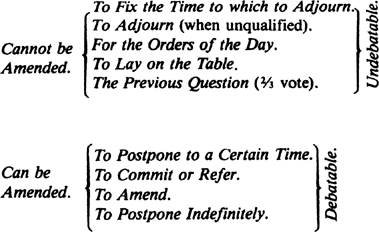
The motion to Reconsider can be made when any other question is before the assembly, but cannot be acted upon until the business then before the assembly is disposed of [see note 9 above], when, if called up, it takes precedence of all other motions, except to adjourn, and to fix the time to which to adjourn. Questions incidental to those before the assembly take precedence of them and must be acted upon first.
HOW TO USE THE TABLE IN MIDST OF BUSINESS
When a motion is made, turn to the Order of Precedence of Motions, , to see if it is in order. If it is in order and more information is wanted than is there furnished, look for the motion in the Table, and glance along the line to see if there are any black squares in the columns. If there are no black squares, then the rules at the head of the columns do not apply, and the motion is just like any resolution or amendmentthat is, (1) it is debatable; (2) the debate must be strictly confined to the motion; (3) it can be amended; (4) it can be reconsidered; (5) it requires a majority vote for its adoption; (6) it requires to be seconded; and (7) it is not in order when another has the floor. These general principles should be fixed in the mind and they should be strictly observed, unless a black square shows that the motion is an exception to the general rule, or a figure refers to a note showing to what extent it is an exception. In this way the chairman or any other member may in a moment learn the correct rulings on all the above points.


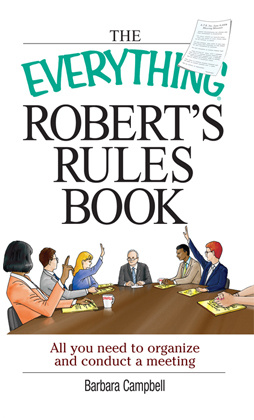

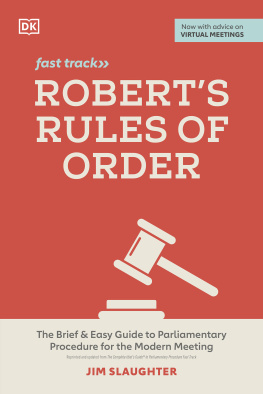
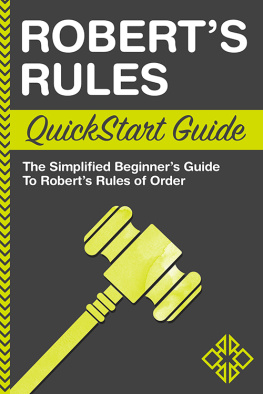
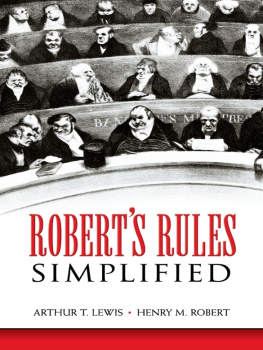
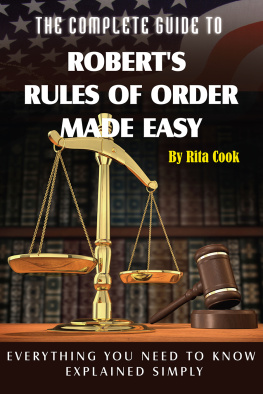
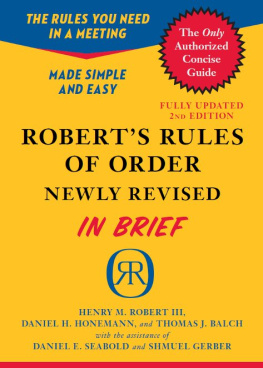
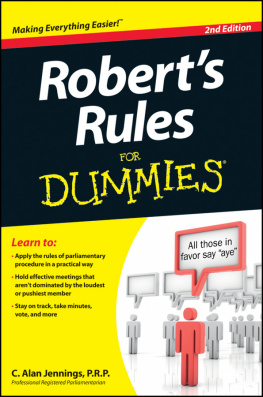
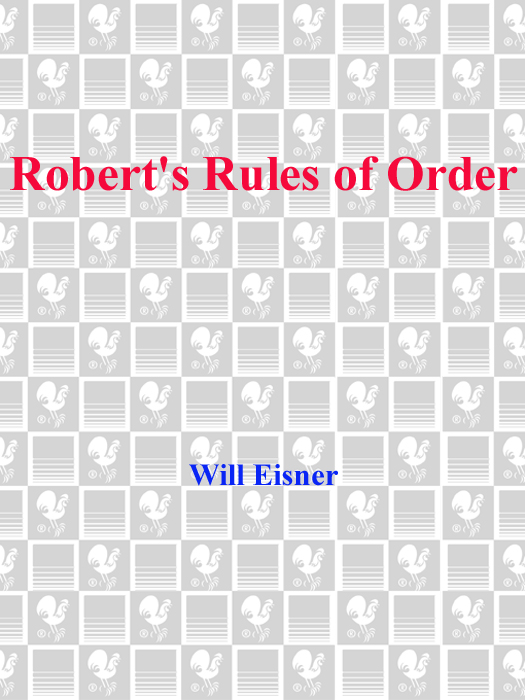
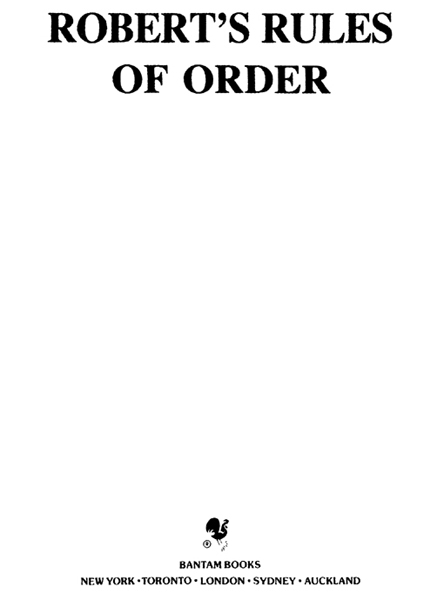
 Black square shows which rule applies
Black square shows which rule applies Number refers to Notes
Number refers to Notes Every motion in this column has the effect of suspending some rule or established right of deliberative assemblies (see note to ), and therefore requires a two-thirds vote, unless a special rule to the contrary is adopted.
Every motion in this column has the effect of suspending some rule or established right of deliberative assemblies (see note to ), and therefore requires a two-thirds vote, unless a special rule to the contrary is adopted. An Amendment may be either (1) by adding or (2) by striking out words or paragraphs; or (3) by striking out certain words and inserting others, or (4) by substituting a different motion on the same subject; or (5) by dividing the question into two or more questions as specified by the mover, so as to get a separate vote on any particular point or points.
An Amendment may be either (1) by adding or (2) by striking out words or paragraphs; or (3) by striking out certain words and inserting others, or (4) by substituting a different motion on the same subject; or (5) by dividing the question into two or more questions as specified by the mover, so as to get a separate vote on any particular point or points. An Appeal is undebatable only when relating to indecorum, or to transgressions of the rules of speaking, or to the priority of business, or when made while the Previous Question is pending. When debatable, only one speech from each member is permitted. On a tie vote the decision of the Chair is sustained.
An Appeal is undebatable only when relating to indecorum, or to transgressions of the rules of speaking, or to the priority of business, or when made while the Previous Question is pending. When debatable, only one speech from each member is permitted. On a tie vote the decision of the Chair is sustained. An affirmative vote on this motion cannot be reconsidered.
An affirmative vote on this motion cannot be reconsidered. The objection can only be made when the question is first introduced, before debate.
The objection can only be made when the question is first introduced, before debate. Allows of but limited debate upon the propriety of the postponement.
Allows of but limited debate upon the propriety of the postponement. The Previous Question, if adopted, cuts off debate and brings the assembly to a vote on the pending question only, except where the pending motion is an amendment or a motion to commit, when it also applies to the question to be amended or committed.
The Previous Question, if adopted, cuts off debate and brings the assembly to a vote on the pending question only, except where the pending motion is an amendment or a motion to commit, when it also applies to the question to be amended or committed. Can be moved and entered on the record when another has the floor, but cannot interrupt business then before the assembly; must be made on the day, or the day after, the original vote was taken, and by one who voted with the prevailing side.
Can be moved and entered on the record when another has the floor, but cannot interrupt business then before the assembly; must be made on the day, or the day after, the original vote was taken, and by one who voted with the prevailing side.
